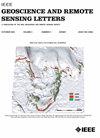基于一般各向异性的三维海洋电磁正演模拟
IF 4
3区 地球科学
Q2 ENGINEERING, ELECTRICAL & ELECTRONIC
引用次数: 2
摘要
为了研究方位各向异性对频率域海洋可控源电磁(CSEM)响应的影响,本文提出了一种基于边缘的自适应有限元(FE)建模算法。三维算法能够处理一般各向异性的导电介质。它是在非结构化的四面体网格上实现的,这允许复杂的几何模型。通过自适应网格细化控制有限元解的精度,迭代求解,直到解收敛到期望的精度公差。针对具有各向异性的一维分层模型的拟解析解,对该算法进行了验证。然后,我们在一组三维各向异性模型上模拟了海洋CSEM的响应,并说明了方位各向异性对海洋CSEM的响应都有相当大的影响,但程度不同。本文章由计算机程序翻译,如有差异,请以英文原文为准。
3-D Marine CSEM Forward Modeling With General Anisotropy Using an Adaptive Finite-Element Method
To investigate the effect of azimuthal anisotropy on frequency-domain marine controlled-source electromagnetic (CSEM) responses, an adaptive edge-based finite-element (FE) modeling algorithm is presented in this letter. The 3-D algorithm is capable of dealing with generally anisotropic conductive media. It is implemented on unstructured tetrahedral grids, which allow for complex model geometries. The accuracy of the FE solution is controlled through adaptive mesh refinement, which is performed iteratively until the solution converges to the desired accuracy tolerance. The algorithm is validated against the quasi-analytic solutions for a 1-D layered model with anisotropy. We then simulate the marine CSEM responses over a set of 3-D anisotropic models and illustrate that the azimuthal anisotropy has a considerable influence on both the inline and broadside marine CSEM responses but to different extents.
求助全文
通过发布文献求助,成功后即可免费获取论文全文。
去求助
来源期刊

IEEE Geoscience and Remote Sensing Letters
工程技术-地球化学与地球物理
CiteScore
7.60
自引率
12.50%
发文量
1113
审稿时长
3.4 months
期刊介绍:
IEEE Geoscience and Remote Sensing Letters (GRSL) is a monthly publication for short papers (maximum length 5 pages) addressing new ideas and formative concepts in remote sensing as well as important new and timely results and concepts. Papers should relate to the theory, concepts and techniques of science and engineering as applied to sensing the earth, oceans, atmosphere, and space, and the processing, interpretation, and dissemination of this information. The technical content of papers must be both new and significant. Experimental data must be complete and include sufficient description of experimental apparatus, methods, and relevant experimental conditions. GRSL encourages the incorporation of "extended objects" or "multimedia" such as animations to enhance the shorter papers.
 求助内容:
求助内容: 应助结果提醒方式:
应助结果提醒方式:


